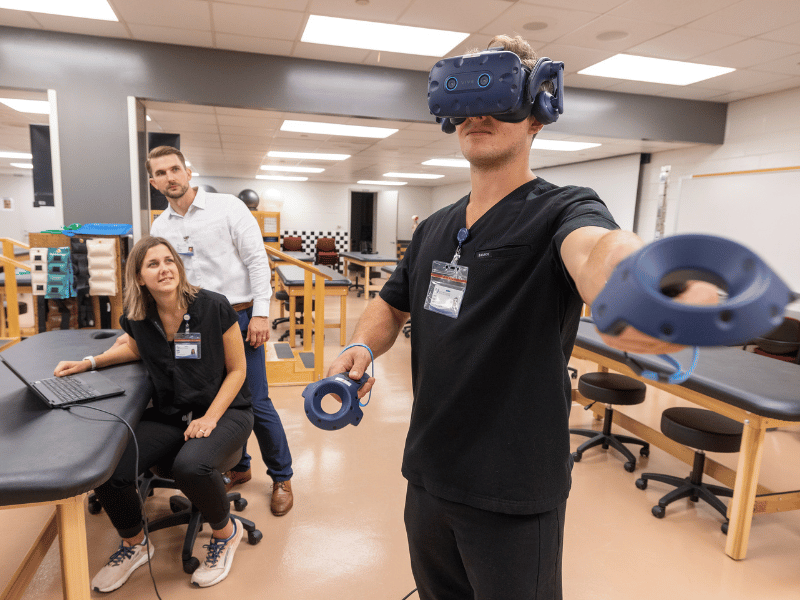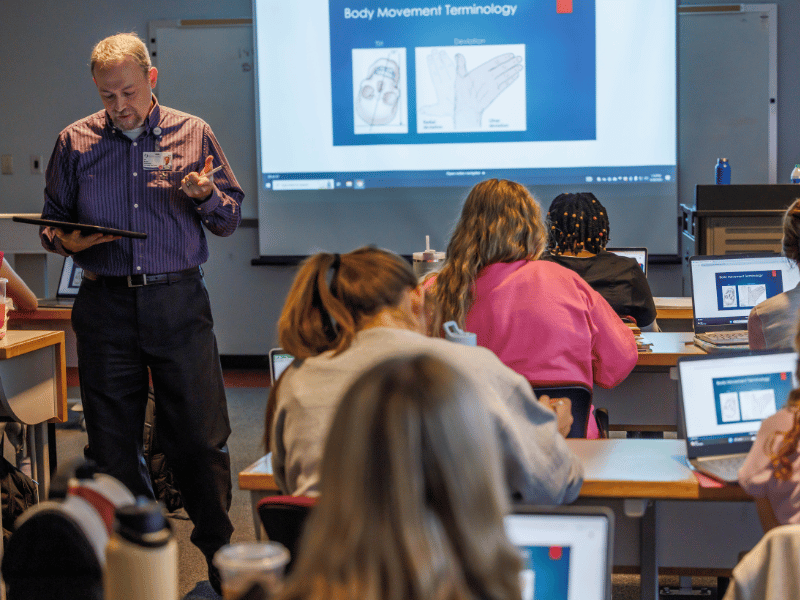Technological advances reshape rapidly evolving class settings at SHRP

Editor's Note: This article first appeared in the 2023 issue of SHRP Reach, the annual publication for the School of Health Related Professions.
The tools of the trade change nearly every semester in all 12 programs in the School of Health Related Professions. Whether it’s measuring the progress of head injury cases or simply keeping students’ minds fresh during class lectures, the topics of virtual reality, artificial intelligence and assistive devices grow more advanced – and costly, leaders say.
In the otherwise highly hands-on physical therapy program, students have traveled to a virtual landscape of shapes and images to partner in a study on concussions that hopes to build on progress made in understanding the sports world’s most talked-about medical topic of the 21st century.
“We’re looking at working with VR headsets in the classroom for our first-year students,” said Dr. Jacob Daniels, assistant professor in the Doctor of Physical Therapy program. “There’s plenty of potential in the use of the headsets as we simulate being with patients during our education sessions and practicing our interviewing and data analysis skills.”

Daniels, three other PT faculty members and a handful of PT students are collaborating with researchers in UMMC’s School of Population Health in recent years to look at ways to prevent or lessen the impact of sports-related concussions. Subjects in the study funded by a grant from the National Institutes of Health put on the futuristic gear while eye movements and general neurological reactions to images shown are analyzed.
“They can already be used to get patients in home exercise programs buy into it and be less reluctant to participate because it’s more fun,” said Jacob Lape, of Jackson, a third-year PT student and participant in the ongoing study.
“It also has potential in helping older adults improve their balance.”
In occupational therapy, getting those with physical or developmental conditions to communicate wants and needs often involves devices that can bridge gaps between mind and body.
“Part of our job as occupational therapists is to obtain these devices for patients, and state their benefits from it due to lack of communication from them often being nonverbal,” said Abbey Stanford, a second-year OT student skilled with augmentative communication devices. “Then, we can come in and help them learn about it and advocate for it in the school system.”
By the second year in the program, students have become familiar with head trackers, which rely on eye movements in those with major spinal cord and related neurological injuries. They’ve also used simpler technology that enable those with at least some fine motor skills to communicate, mostly through choosing images such as family, vehicles and feeling.

“These devices help us help patients communicate with their families, their therapists and, in some cases, their teachers to express how they’re feeling, or whether they want to go to the bathroom,” said Tejay Patel, of McComb, also a second-year OT student. “And they’re highly customizable, depending on the diagnosis.”
Such specialization with the user in mind is the goal of instructional software in classrooms everywhere, especially in radiologic technology.
In 2023, radiologic science educators nationwide reported lower student test scores despite having a 100% first-time pass rates on the national board exam. The solution, said Radiologic Sciences Department Chair Kristi Moore, is interactive technology in the classroom – enter Nearpod.
Two classes were refashioned in the fall semester to use the instructional software that incorporates virtual reality, 3D presentations, simulation along with traditional activities like polls and message boards.
“We will “Nearpod-ize” three courses in spring 2024 and eventually transition them all to the program,” Moore said. “It was part of our team of instructors brainstorming solutions to improve student engagement and participation. We look for this to result in increased comprehension throughout the program and improved board exam scores upon graduation.”
It’s surely working for Megan Espinoza, a Texas native and first-year student in 2023 who arrived on campus not knowing just how much she needed Nearpod. She found out in a hurry and praised it from the start.

“I like having something to do, because it helps my brain,” Espinoza said. “It’s geared better to people who learn better by doing. It keeps you on your toes. It might be set up one day without quizzes or anything extra to do, but you have to be ready just in case they do.
One of the courses being converted to Nearpod in 2024, Research Methods, will become a vehicle for comparing pre- and post-Nearpod performance and for incorporating the year’s most intriguing – and controversial – topic into the course content.
“I will incorporate AI into the course content to show students how AI can be useful as a starting point for creating papers and presentations, while also discussing issues they may encounter and what to avoid,” Moore said.
The buzz generated by the worldwide launch in fall 2022 of highly-refined AI platforms wasn’t lost on program directors. They see its proper role in SHRP’s tech-heavy fields as supplementary. AI can be used to craft criteria for written assignments while making sure students are the ones in control of their own learning process. In the short term, directors say the most competent set of human hands to handle AI might well be that of teachers, mainly to improve that process for students.

“AI can help students make diagnoses, create plans of care, develop new quality assurance models, organize data and more,” said Dr. Robin Benson Thompson, director of the Office for Academic Innovation. “This level of learning helps students develop strong analytical and critical thinking skills. It also can help faculty detect trends in student performance and develop plans to ensure the student succeeds. It can help faculty automate processes that were historically time-consuming, which frees up time for faculty to devote to enhancing lectures, personalizing learning experiences for students, conducting research, among other things.”
For students and faculty, a glimpse into the future of all SHRP programs might reveal the most intriguing advances might not necessarily involve fancy headgear at all.
“In the field of physical therapy, we will eventually be able to screen patients using a form of AI for hidden diagnoses that might present as a musculoskeletal issue, but maybe it’s something else going on – like an endocrine or autoimmune disorder,” Daniels said. “That technology can be more accurate and reliable than human screening at doing that. Besides, we’re all familiar with Siri and the things it can do. Most of us carry around an AI device in our pocket every day.”



